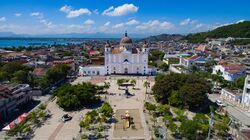Nossa-Senhora-de-Manassa
This article is incomplete because it is pending further input from participants, or it is a work-in-progress by one author. Please comment on this article's talk page to share your input, comments and questions. Note: To contribute to this article, you may need to seek help from the author(s) of this page. |
Nossa-Senhora-de-Manassa | |
|---|---|
 The Catedral de Nossa-Senhora-de-Manassa, one of Maracao's largest cathedrals built in the Luzelese colonial style | |
| Etymology: Luzelese for "Our Lady of Manassa" | |
| Nickname: La Senhora ("The Lady") | |
| Country | Maracao |
| Province | Aldiriz |
| Town | Porto Leste |
| Settled | 1580 |
| Municipalities | 20 municipalities
|
| Government | |
| • Type | Elected executive mayoralty with a consultative assembly of workers' council delegations |
| • Body | Nossa-Senhora-de-Manassa City Council |
| • Mayor | Rui Bento (Ind.) |
| Area | |
| • Land | 32.71 km2 (12.63 sq mi) |
| • Water | 2.09 km2 (0.81 sq mi) |
| • Metro | 819.67 km2 (316.48 sq mi) |
| Elevation | 2 m (7 ft) |
| Population (2018) | |
| • Sub-metropolitan level city | 317,090 |
| Demonym | Cuirinatí |
| Time zone | UTC+12 (Central Asterian Time) |
Nossa-Senhora-de-Manassa (Maracan Luzelese pronunciation:; Maracan Creole: Nobo-Senora-den-Manèsa), also known colloquially as A Senhora ("The Lady") or abbreviated to NSM is a city in south-eastern Maracao, part of the Greater Porto Leste metropolitan area. With a population of 317,090, it is the second-largest urban locality in Maracao. The city is famed for its vibrant and diverse urban culture, including street food, street music, parades, street carnivals and street markets.
The city was first settled in 1580, 31 years after Porto Leste. It became a popular trade hub and port for Luzelese traders arriving from Euclea, Coius and the continental Asterias, and grew exponentially as a wealthy area of the country. Its centrepiece, the Cathedral of Our Lady of Manassa, was built in 1616, and is one of the best-preserved examples of Luzelese colonial architecture in Maracao. After Maracao's independence in 1884, the city was a popular destination for the settlement of freed slaves, both from Maracao and elsewhere in the Asterias where slavery had been abolished. It also attracted some migration directly from Bahia, which led to the fusion of a multitude of different cultures that defines the city's urban life to this day. Another migratory wave bolstered the city's population after the Great War.
The city is a popular tourist destination, with beach resorts lining the city's Meruoca beach. It is also known for the Carnaval dos Mil Crânios, Maracao's largest festival commemorating the dead. The Natí are the native inhabitants of the area, which gave rise to the city's demonym, Cuirinatí, meaning "town of the Natí".